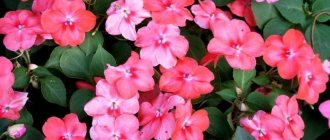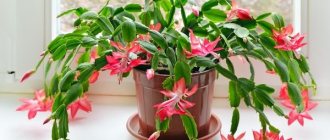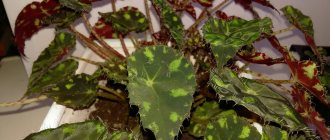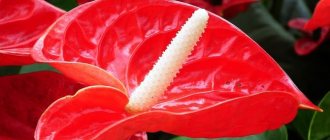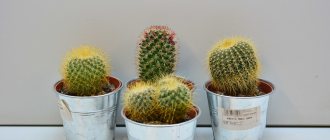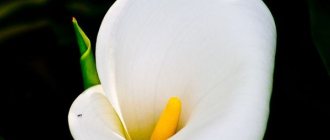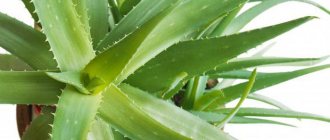Echeveria belongs to the Crassulaceae family and is widely distributed in nature in the plains and mountainous regions of Mexico and America. People also call it young cabbage, hare cabbage and stone rose. Indeed, the resemblance to a rose is simply amazing: juicy petals of the most varied colors form a rosette, reminiscent of everyone’s favorite flower. There are numerous signs and superstitions associated with the stone rose, which will be discussed in this article.
In the Middle Ages, young trees thickly covered the roofs of houses. It was believed that they were able to protect buildings from lightning strikes. Allegedly, Charlemagne himself firmly believed in this and forced his subjects to follow his command. It is thanks to this belief that the plant variety Roofing has survived to this day, which is distinguished by the most varied colors of leaves and a large, dense peduncle consisting of 40–100 flowers. Today, hare cabbage can no longer be found on the roofs of houses, but it is widely used in landscape design, in particular, decorating paths and borders, creating alpine slides, etc.
The plant is quite unpretentious to soil quality and ambient temperature, but some varieties are still recommended to be brought indoors for the winter. In this regard, many are interested in whether it is possible to keep a stone rose at home, because the signs regarding this are generally unfavorable. It is believed that juveniles are a cemetery flower and are completely unsuitable for growing at home. Here everything will depend on how the person himself relates to these superstitions, because not only young flowers are grown on graves, but also tulips and daffodils, which no one considers to be cemetery flowers. The tulip has been considered a symbol of International Women's Day for several decades.
This flower is widely used not only for landscaping, but also for office decoration, because it fits perfectly into any minimalist interior and does not require special care. It is not watered often, and there is no need to select the optimal direction of light - the plant feels great under the sun. All the negative signs about the stone rose in the house are completely unfounded, because it is even included in wedding bouquets, and in organizing such an event, everything, every little thing matters. Therefore, you should not be afraid of anything and try to plant this beautiful unusual flower on your windowsill, which will delight the eye at any time of the year.
Many people like the stone rose - signs and superstitions associated with echeveria will help you figure out whether it is worth keeping this plant in your home.
Wonderful plant Echeveria
This plant is distributed mainly in America and Mexico, growing on plains or mountain deserts. In the territory of central Russia and the Caucasus there are species of echeveria. Echeveria has received many names among the people: stone rose, hare cabbage, young, tenacious.
Photo of stone rose
The comparison with a rose or cabbage is not accidental, because if you look at the appearance of the plant, you will understand that it resembles both a rosebud and white cabbage.
The plants are used as decoration; often in folk medicine, certain types of juvenilia are used to treat fever, epilepsy and various other diseases. In ancient times, girls believed that it could be used to remove freckles and age spots.
Quartblog Digest
Succulents: types of cute fat ones and caring for them - The most complete instructions for caring for succulents at home. We will show examples of plants in the interior.
How to grow Vanilla Frize hydrangea if you don’t know anything about it - Kvartblog tells how to grow Vanilla Frize hydrangea, what is required for care, and shows photo examples of how beautifully this plant blooms.
Know and be able to: how to grow orchids - We will tell you how to grow and care for several types of indoor orchids at home, which are often sold in stores.
Hanging flower pots: DIY and more - Eight tutorials to help you make the perfect hanging flower pot, and eight links to ready-made items.
Artificial flowers in the interior - The skillful art of imitation. Artificial flowers in the interior - beautiful examples, useful tips and important recommendations from Kvartblog!
Signs about indoor stone rose
In the Ancient Roman Empire, the stone rose was considered endowed with special magical powers. She was credited with the ability to protect against black magic.
The plant turned out to be really tenacious. It can grow in mountains, crevices, on sand and clay, practically does not need moisture, and can tolerate heat and frost. The young will survive in any weather conditions. That is why the plant, capable of surviving in any situation, protecting from evil spirits, thunder and lightning, has long been considered a protector, a good talisman.
Another common superstition is that the stone rose is a cemetery flower, unfavorable, charged with negative energy. Therefore, many people refuse to keep it in their homes. As you can see, this opinion differs from the above. And in cemeteries it is planted only because of its ability to survive without long-term watering.
Negative superstitions
Reference! Previously, they planted beautiful echeveria on graves , believing that it would cleanse the dead and help them get to heaven faster. The plant supposedly brings peace to the dead.
The most unpretentious plant is really very convenient to plant on graves, because it does not require care, watering, and is an excellent decoration.
Because of this, some people are afraid to keep this wonderful young thing at home. Old prejudices are becoming a thing of the past, and the benefits of echeveria have long been proven by experts.
Opinion of psychics and bioenergetics
Psychics and bioenergetics experts agree that, in general, this plant does not attract bad luck and does not harm the owner of the room.
You should not be afraid of the superstition that says that young people have cemetery energy, since there is no confirmation of such an opinion, and it is unlikely that such a terrible attribute would have been used then for so many years as a talisman against evil forces and bad weather.
Of course, it is very important how you feel about this flower. If you are afraid of it, doubt that it is filled with positive energy, will have a good influence on your life, and will not cause damage, then the result will be appropriate.
It does not matter at all in which part of the apartment the stone rose will be located, since the flower has completely neutral energy. Of course, if you love this plant, talk to it, fill it with your positive energy, then it will be able to increase it several times.
In addition, if you believe that the stone rose is your reliable talisman against any adversity and black magic, then it will be so.
As you can see, the stone rose is a neutral plant, and you can have it in your home without fear. Don't be afraid, don't think about the bad superstitions associated with this flower. After all, if you like him and doesn’t cause any negative emotions, then he won’t bring any negativity into your life.
Echeveria (Echeveria) is capable of creating interspecific and intergeneric hybrids, for example pachyveria (XPachyveria), sediveria (XSediveria), graptoveria (XGraptoveria).
Echeveria (echeveria) is named after a 19th century Mexican artist. Atanasio Echeverria, who illustrated books on the flora of Mexico.
Representatives of the genus Echeveria (echeveria) are succulents, stemless, perennial, herbaceous, low-growing plants, sometimes subshrubs with a short branched fleshy trunk.
The leaves are arranged very densely, spirally, form a rosette, entire edges, more or less fleshy, flat to rounded, green, covered with a grayish-white bloom, somewhat reddening.
The leaves are arranged very densely, spirally, form a rosette, entire edges, more or less fleshy, flat to round, green. Sometimes a reddish coating can be seen along the edge of the leaf blade.
Different types of echeveria have different protective covering: some have a waxy grayish-white coating, others have pubescence. This helps the plant protect itself from direct sunlight. The peduncle is 30-90 cm long, axillary, sometimes branched, racemose, or the flowers are umbellate. The flowers are numerous.
What is young, its types and varieties, how does it bloom?
Young is a very beautiful perennial plant that does not require special care. It will ideally decorate any yard; it can be used to create an alpine slide. Also, a very exciting creative process of creating interesting compositions from different types and varieties of this miracle flower. It is simply impossible not to fall in love with it; it amazes with its rich appearance, unusual shape and has healing properties.
Juvenile is an evergreen, durable, 20-centimeter plant with a straight stem, fleshy leaves, pointed at the top and covered with a special film that protects against rapid evaporation of moisture. Spiral-shaped leaves grow around the rosette in the form of a cocoon. They fit tightly to each other, forming small balls. Its roots do not penetrate deep into the ground, but are located above.
Rejuvenated
That is why, a very long time ago, this plant was planted on the roofs of houses; it looked very unusual, but at the same time environmentally friendly. Flowers of different shapes, colors and heights.
Since these plants are not whimsical and do not require much effort to grow, there are many species, varieties and even hybrids that amaze with their unusual beauty. The area of their growth is very large: from Asia and Northern Africa and right up to Central Europe.
Juveniles can change their color in sunny weather, with excellent soil that meets all the necessary characteristics for this variety and species, depending on the time of year, as well as as they grow intensively. Each of the existing species differs not only in coloring, speed of leaf growth, plant size and rosette structure, but also in the speed of reproduction, size and shades of flowers, height of peduncles and time of flowering and fading. Let's take a closer look at what types of this wonderful plant exist and delight many people with their beauty:
- Juveniles, which reproduce by shoots , grow mainly near the great lakes , where the soil is sufficiently moist and there is a lot of sunlight . Greenish shoots with red edges form a spiral, holding on to thin stems, which it is advisable to tear off for rooting of young shoots.
- The cobwebby juvenile is distinguished by small processes only two centimeters wide. It received this name because of the many small fibers in the middle, which resemble a spider’s web.
Cobwebby young
- Roofing young is very common all over the world. It was from him that experienced gardeners bred new varieties or crossed existing ones to produce hybrids. It has a large rosette, up to ten centimeters wide. The leaves are massive, their edges have a reddish tint. Flowers can be of different shapes and shades.
Roofing was young
- Mountain varieties of this plant have very large shoots, and the leaves at the base are very rich green; they delight with their beauty all tourists who love to breathe clean air and see the beauty of the area from the mountain heights of the Caucasus. Abundant flowering occurs in July - mid-August.
Mountain rejuvenated
- Russian young grows in the forest-steppe zone, also has green leaves and a rich, bright flower and a long peduncle.
Russian made you look younger
- The spherical juvenile can be found on the slopes of the famous Caucasus Mountains. The width of its rosette is only three centimeters, and the green leaves, shimmering in the sun, give off a slight reddish tint.
Ball-shaped young
- Marble juveniles fascinate with the depth of color and the diameter of the rosettes, which can be up to twelve centimeters. The leaves are soft green, interspersed with red.
Marble was young
- The leaves the sandy young are smooth with red edges; the shoot can be up to fourteen centimeters wide and two centimeters high.
Sandy young
- The inflorescences of the low-growing juvenile contain an average of seven purple flowers with a contrasting line along the entire length of the petals.
The undersized young man
The following varieties of this famous plant are extremely popular:
- "Princess" variety is very suitable for creating floral designs, green balls with a dark brown coating
- It goes well with the Pharaoh , which has deep purple leaves with a green covering.
Variety "Pharaoh"
- Hybrid "Montana" has rich green shoots with a delicate purple coating.
Montana
- But the “Julia” amazes with the width of its marsh-colored rosettes, which begin to turn red by the arrival of the first autumn coolness.
"Julia" in autumn
Each shoot of a stone rose blooms only once, after flowering it dies, and new ones grow from the remaining small children. Adults, established young ones, bloom much faster and manage to grow many children during flowering, but young ones do not.
The young blooms profusely and for a long time throughout the hot summer months, delighting owners and passers-by. Various colors to suit every color and taste.
Watering and air humidity.
Echeverias (echeverias) are watered sparingly in spring and summer. Between waterings, the earthen ball should dry out completely. Plants cannot tolerate excess moisture. In extreme heat, on a sunny windowsill, echeveria (echeveria) leaves may wrinkle, which means the plant should be watered.
In the autumn-winter period, watering is extremely rare (especially when the plant is kept in cool conditions).
When keeping echeveria (echeveria) in winter under normal (18-20°C) temperature conditions, it may be necessary to water the plants a little more often. The signal for watering is when the leaves wilt.
Water with soft, well-settled water. When watering, you need to make sure that water does not get on the rosettes of leaves - this can cause them to rot, and in bright sunshine they can get burned. It makes sense to use bottom watering.
Read the continuation on the next page by clicking its number below.
Air humidity does not play a significant role for echeveria. The plant can tolerate dry air well and does not need spraying. Moreover, spraying may deteriorate the appearance of the plant.
Rest period.
From October to February. Plants are kept in a place with bright light, in cool conditions. Water very rarely, as needed (when the leaves wither).
In the spring-summer period, feed once a month with fertilizers for cacti of low concentration. Fertilizing with a weak solution of mineral fertilizers is done with caution. Excess fertilizer has a negative effect on the appearance of the plant. The use of fertilizer with a high nitrogen content is not permissible. In autumn and winter, the plant is not fed.
Echeverias (echeverias) are short-day plants, but they respond to changes in day length; therefore, by adjusting the length of the day, it is possible to change the flowering time.
The most favorable conditions for the formation of flowers are a temperature of 15-18°C and a short day - 12-13 hours for 50 days.
Agricultural technology
Important! Stone rose is a very unpretentious flower, so even a novice gardener can take care of it. The succulent blooms well both at home and in the garden, at the dacha
Landing
In open ground, stone rose can be planted in the most inaccessible places. It will feel good in the space between stones, wide flowerpots, any pots and containers. The unpretentiousness of the flower is explained by its high resistance to any conditions: drought and severe frost.
To get a rich shade of leaves, it is better to choose a well-lit place to plant a stone rose. In the shade it will look pale. When growing at home, the pot should be kept on a southern windowsill and provided with additional lighting.
Suitable soil for a flower is light, sandy. Drainage in the form of pebbles, expanded clay, and small crushed stone is required. Juveniles tolerate an acidic environment less well, so you should not add fertilizers. At home, a mixture of sand and peat, mixed in a 3:1 ratio, with the obligatory addition of drainage, is suitable.
Important! Flower seedlings are planted in the spring-summer season, in previously loosened soil, cleared of weeds, diluted with sand and pebbles. The holes are made at a distance of 20 cm from each other. Leave 5 to 7 cm of space between dwarf flower varieties.
The seedlings, together with a lump of earth, are placed at a shallow depth, sprinkled with soil, compacted and watered.
Leave 5 to 7 cm of space between dwarf flower varieties. The seedlings, together with a lump of earth, are placed at a shallow depth, sprinkled with soil, compacted and watered.
The stony rose is planted mainly as seedlings, since many daughter rosettes form around it. No wonder the French gave her another name - “mother hen with chicks.” When growing indoors, the “daughters” of the stone rose are separated in September and placed in separate containers.
Note! When propagated by seeds, flower growth slows down. Sowing of seeds occurs at the beginning of March. A week later, seedlings appear and are transplanted to a permanent place in the first days of July.
A week later, seedlings appear and are transplanted to a permanent place in the first days of July.
Sowing of seeds occurs at the beginning of March. A week later, seedlings appear and are transplanted to a permanent place in the first days of July.
Despite the unpretentiousness of the stone rose, it is still worth paying attention to proper agricultural technology:
- Watering the flower should be rare, once a week in summer, and as needed in winter. Overmoistening of the soil, moisture getting inside the rosettes - all this causes rotting of the roots and leaves of the rose. You need to water at the root.
- Weeding should be regular and careful so as not to damage young rosettes.
- The flower does not need fertilizing. Only after 3-4 years can you use mixtures to feed cacti, and it is recommended to add crushed charcoal. You can use humus.
- There is no need to spray or wipe the leaves of the flower, as they have their own protection in the form of a film. Drops of moisture under the sun can cause burns.
- After flowering, it is recommended to remove the dried inflorescence to allow the flower to regain its strength for the new season.
Important! It is recommended not to replant the stone rose, but to plant it. To prevent numerous daughter rosettes from becoming smaller, they are seated in another place. Stone rose tolerates frost well under snow cover
To do this, it dries out in the fall, getting rid of excess moisture in the leaves. But recently planted, fragile flowers should be covered with foliage or branches of coniferous trees
Stone rose tolerates frost well under snow cover. To do this, it dries out in the fall, getting rid of excess moisture in the leaves. But recently planted, fragile flowers should be covered with foliage or branches of coniferous trees.
Reproduction.
Echeverias (echeverias) are easily propagated by leaves, cuttings, rosettes and seeds. Subshrubs are also propagated by the tips of their shoots.
Seeds are sown in late February early March. In a mixture of peat and sand (1+1). Maintain the temperature within 20-22°C, constantly spray and ventilate. Shoots appear in 12-14 days. When the seedlings grow up, they are planted in small containers with a substrate: leaf soil and sand (2:1). When the seedlings' rosette of leaves reaches 2-3 centimeters in diameter, they are transplanted into appropriate-sized pots with a mixture for adult plants.
Cuttings are planted in bowls, pots or sowing boxes. Before planting, the cuttings (and leaves) are slightly withered. Composition of soil for cuttings: clean sand or compost soil - 1 tsp, mixed with sand - 1 tsp. Cuttings root quickly.
Cuttings are taken in the spring - in March-May, but cuttings can be taken throughout the growing season. Rooted cuttings are planted one at a time in small pots (7 cm). For floral decoration, in the first year, small rosettes of leaves are cut from the roots, since after rooting they can be used for growing echeverias or other succulent plants in groups.
